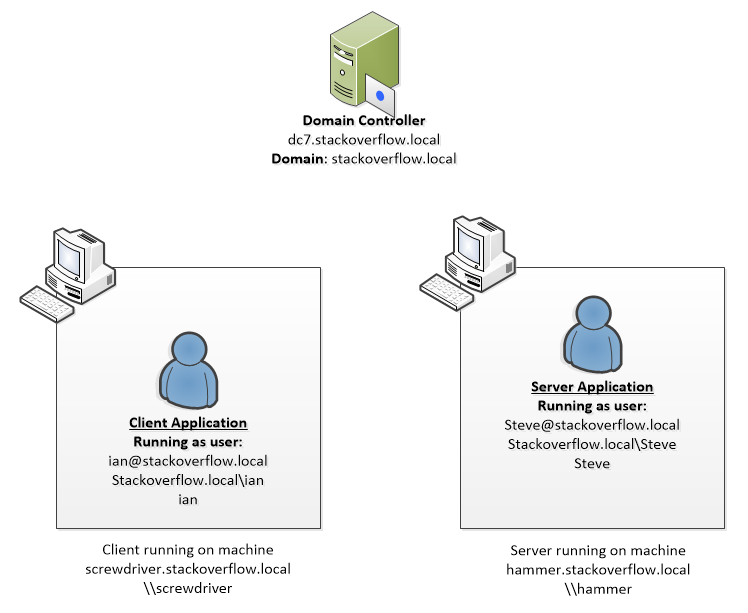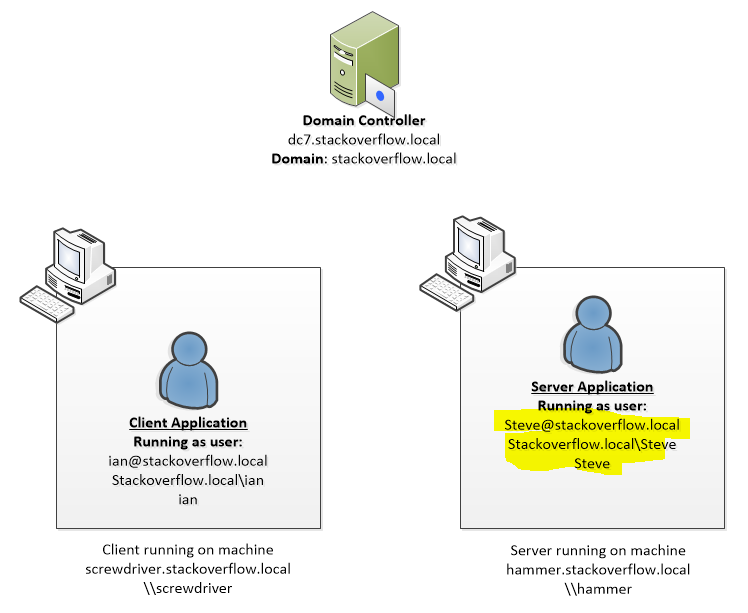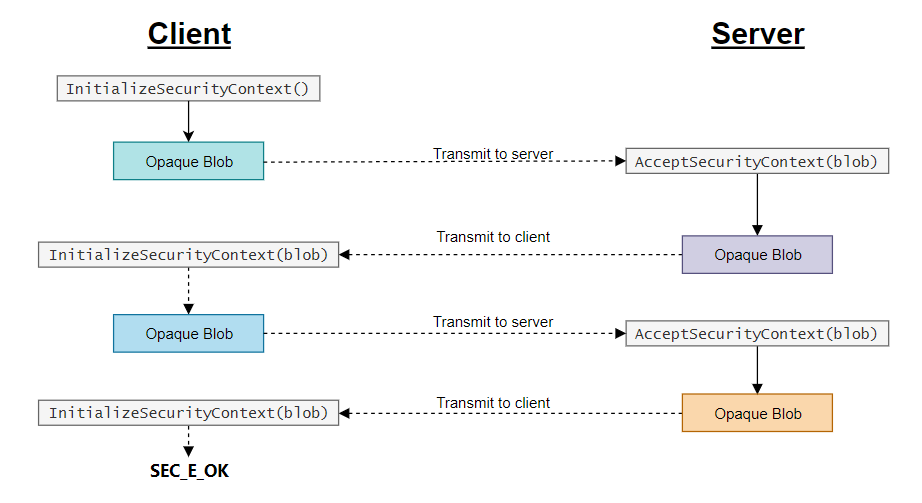The Question
When calling InitializeSecurityContext, what value do i pass to the TargetName parameter?
Revised Background
I'm calling the function InitializeSecurityContext:
InitializeSecurityContextA(
@pAS.hcred, //[in] credentials
phContext, //[in] optional] Context handle structure
pszTargetName, //[in, optional] Target name
0, //[in] context requirements
0, //[in] reserved1, must be zero
SECURITY_NATIVE_DREP, //[in] target data representation
pInput, //[in] optional] SecBufferDescription
0, //[in] reserved2, must be zero
@pAS.hctxt, //[in, out] pointer to context handle structure
@OutBuffDesc, //[in, out] pointer to SecBufferDesc
ContextAttributes, //[out] context attributes
@lifetime); //[out] expiration timestamp
What do i pass to pszTargetName?
I've tried
null:InitializeSecurityContextA(@pAS.hcred, phContext, null, ...);"":InitializeSecurityContextA(@pAS.hcred, phContext, "", ...);"spn/HOSTNAME":InitializeSecurityContextA(@pAS.hcred, phContext, "spn/HOSTNAME", ...);spn/HOSTNAME.DOMAIN.COM:InitializeSecurityContextA(@pAS.hcred, phContext, "spn/HOSTNAME.DOMAIN.COM", ...);"cargocult/PROGRAMMING":InitializeSecurityContextA(@pAS.hcred, phContext, "cargocult/PROGRAMMING", ...);"http/TFS.DOMAIN.COM":InitializeSecurityContextA(@pAS.hcred, phContext, "http/TFS.DOMAIN.COM", ...);"http/HOSTNAME":InitializeSecurityContextA(@pAS.hcred, phContext, "http/HOSTNAME", ...);"qwertyasdf":InitializeSecurityContextA(@pAS.hcred, phContext, "qwertyasdf", ...);"AuthSamp":InitializeSecurityContextA(@pAS.hcred, phContext, "AuthSamp", ...);
They all either fail, or downgrade to NTLM.
Note: My machine is domain joined, but the domain is not named domain.com, or even hostname.domain.com, or even qwertyasdf. So i'm not surprised that those attempts fail. But people said try things like http/HOSTNAME, so i put in http/HOSTNAME.
Background
The InitializeSecurityContext (Negotiate) function has an optional TargetName parameter:
pszTargetName [in, optional]
A pointer to a null-terminated string that indicates the service principal name (SPN) or the security context of the destination server.
Applications must supply a valid SPN to help mitigate replay attacks.
What is this supposed to be?
More Background
i am trying to validate a set of user's credentials, e.g.:
Boolean ValidateCredentials(String username, String password, String domain)
{
...
}
Validating a set of user's credentials requires using the SSPI API. The first function to call is InitializeSecurityContext. One of the parameters to InitializeSecurityContext is a "TargetName" string.
i've tried leaving it null, but the Application Verifier triggers a breakpoint, writing out the error:
VERIFIER STOP 00005003: pid 0xF08:
InitializeSecurityContext uses NULL target or malformed target for Kerberos service.
Please see pszTargetName for the value of the target.
00000000 : Not used.
00000000 : Not
At this point it would be helpful to remember that the Negotiate provider will attempt to use Kerberos, but fallback to NTLM. In the case of Negotiate, Kerberos or NTLM, the TargetName parameter is documented to be:
Service principal name (SPN) or the security context of the destination server.
But then what should i pass?
i tried doing what the SSPI Knowledge Base article does, nothing (i.e. pass NULL):
How to validate user credentials on Microsoft operating systems
ss = _InitializeSecurityContext( &pAS->hcred, pAS->fInitialized ? &pAS->hctxt : NULL, NULL, //<-------pszTargetName 0, 0, SECURITY_NATIVE_DREP, pAS->fInitialized ? &sbdIn : NULL, 0, &pAS->hctxt, &sbdOut, &fContextAttr, &tsExpiry);
But nothing (i.e. NULL) doesn't work.
Note: The KB article was massivly rewritten in 2007. In its original 1999 incarnation they passed "AuthSamp" as the target, but that also fails.
service principal name
(SPN) The name by which a client uniquely identifies an instance of a service. If you install multiple instances of a service on computers throughout a forest, each instance must have its own SPN. A given service instance can have multiple SPNs if there are multiple names that clients might use for authenticationsecurity context
The security attributes or rules that are currently in effect. For example, the current user logged on to the computer or the personal identification number entered by the smart card user. For SSPI, a security context is an opaque data structure that contains security data relevant to a connection, such as a session key or an indication of the duration of the session.
Bonus Chatter 2
From the application verifier documentation:
The Verifier plug detects the following errors:
The NTLM package is directly specified in the call to AcquireCredentialsHandle (or higher level wrapper API).
The target name in the call to InitializeSecurityContext is NULL.
The target name in the call to InitializeSecurityContext is not a properly-formed SPN, UPN or NetBIOS-style domain name.
The latter two cases will force Negotiate to fall back to NTLM either directly (the first case) or indirectly (the domain controller will return a “principal not found” error in the second case causing Negotiate to fall back).
The plug-in also logs warnings when it detects downgrades to NTLM; for example, when an SPN is not found by the Domain Controller. These are only logged as warnings since they are often legitimate cases – for example, when authenticating to a system that is not domain-joined.
In my case the domain i am validating against is null (since i don't know the machine's domain name, or even if there is a domain). But the results are the same if the hard-code my development machine's domain name.
Update 3
Values of pszTargetName that trigger AppVerifier error, but logon succeeds:
null"""AuthSamp""qwertyasdf"- *the name of the domain i'm validating against (e.g.
"avatopia.com") - *the name of the domain the machine is joined to (e.g.
"avatopia.com") - *the name of the domain the user account is located in (e.g.
"avatopia.com")
Values of pszTargetName that do not trigger an AppVerifier error, but logon fails:
"http/HOSTNAME""http/TFS.DOMAIN.COM""frob/GROBBER""cargocult/PROGRAMMING""spn/HOSTNAME""spn/HOSTNAME.DOMAIN.COM"
Values of pszTargetname that do not trigger an AppVerifier error, and logon succeeds:
- none
Update 4
What i'm trying to do: figure out if a username/password is valid.
- i have a username: e.g.
"ian" - i have a password: e.g.
"pass1"
Now there's the further wrinkle that the account ian could be a local account or a domain account. And you need to decide if ian is a local or domain account before you can ask. This is because ian can have two accounts:
ianon domainstackoverflow.comianon local machine
So i need to specify if i want to:
- ask a particular domain (e.g.
stackoverflow.com), or - ask the local machine (which i'll represent as
".")
Now we can come up with a cross reference:
Username Password Domain Machine on domain? Validate as
======== ======== ================= ================== ==============
iboyd pass1 . No Local account
iboyd pass1 (empty) No Local account
iboyd pass1 stackoverflow.com No Domain account
iboyd pass1 . Yes Local account
iboyd pass1 (empty) Yes Domain account
iboyd pass1 stackoverflow.com Yes Domain account
Update 5
It might help to explain what i'm trying to do, then maybe how to do it will become easier. Lets say i walk into a random office building downtown, walk into a random cubicle, and type in a random username and password:

i'm going to try to login to the domain TURBOENCABULATOR. i specified i want to try to authenticate against the TURBOENCABULATOR domain by prefixing my username as:
TURBOENCABULATOR\ian
Note: i highly doubt the network has a domain called turboencabulator, since the name itself only comes from Rockwell automation. The attempt to login will almost certainly fail. But how does Windows check them?
How does Windows attempt to validate these credentials? How does Windows validate the credentials:
- Username: ian
- Password: pass1
- Domain: TURBOENCABULATOR
Does Windows use the Security Support Package Interface? Assuming windows uses Negotiate or Kerberos for authentication, what does Windows pass as the pszTarget parameter? Almost certainly the credentials i enter will not be valid. How will Windows determine if they are valid? What API will Windows call to validate the credentails?
Windows is able to validate credentails. I want to also validate credentials.
Perhaps instead of trying to connect to the TURBOENCABULATOR domain, i try to connect to the turboencabulator.com domain by prepending the domain to my username as turboencabulator.com\ian:

Same question applies. How does Windows validate credentials? i want to do what Windows does. Assuming Windows uses kerberos for authorization, what does Windows pass as the pszTargetName parameter in SSPI?
Perhaps instead of trying to connect to the turboencabulator.com domain, i try to connect to the turboencabulator.net domain:

Note that in this example i've appended the domain name to my username, rather than prepending it.
Perhaps instead of trying to connect to the turboencabulator.net domain, i try to validate the user as a local (machine) account by prefixing my username with .\ as:

How does Windows validate the username and password against the local account database? Does it use SSPI with Negotiate package? If so what value does it pass as the pszTargetName?
People are talking about web servers, http, team foundation server. i really don't know where they're getting that from. Or they talk about editing a user in active directory to ensure something is present - i don't see why i need to edit anything: Windows doesn't edit anything.
What TargetName do i used when calling InitializeSecurityContext in order to validate a set of credentials?
Bonus Chatter
Here's a chapter from the Application Verifier documentation about why they have a test if someone is mistakenly using NTLM:
Why the NTLM Plug-in is Needed
NTLM is an outdated authentication protocol with flaws that potentially compromise the security of applications and the operating system. The most important shortcoming is the lack of server authentication, which could allow an attacker to trick users into connecting to a spoofed server. As a corollary of missing server authentication, applications using NTLM can also be vulnerable to a type of attack known as a “reflection” attack. This latter allows an attacker to hijack a user’s authentication conversation to a legitimate server and use it to authenticate the attacker to the user’s computer. NTLM’s vulnerabilities and ways of exploiting them are the target of increasing research activity in the security community.
Although Kerberos has been available for many years many applications are still written to use NTLM only. This needlessly reduces the security of applications. Kerberos cannot however replace NTLM in all scenarios – principally those where a client needs to authenticate to systems that are not joined to a domain (a home network perhaps being the most common of these). The Negotiate security package allows a backwards-compatible compromise that uses Kerberos whenever possible and only reverts to NTLM when there is no other option. Switching code to use Negotiate instead of NTLM will significantly increase the security for our customers while introducing few or no application compatibilities. Negotiate by itself is not a silver bullet – there are cases where an attacker can force downgrade to NTLM but these are significantly more difficult to exploit. However, one immediate improvement is that applications written to use Negotiate correctly are automatically immune to NTLM reflection attacks.
By way of a final word of caution against use of NTLM: in future versions of Windows it will be possible to disable the use of NTLM at the operating system. If applications have a hard dependency on NTLM they will simply fail to authenticate when NTLM is disabled.
How the Plug-in Works
The Verifier plug detects the following errors:
The NTLM package is directly specified in the call to AcquireCredentialsHandle (or higher level wrapper API).
The target name in the call to InitializeSecurityContext is NULL.
The target name in the call to InitializeSecurityContext is not a properly-formed SPN, UPN or NetBIOS-style domain name.
The latter two cases will force Negotiate to fall back to NTLM either directly (the first case) or indirectly (the domain controller will return a “principal not found” error in the second case causing Negotiate to fall back).
The plug-in also logs warnings when it detects downgrades to NTLM; for example, when an SPN is not found by the Domain Controller. These are only logged as warnings since they are often legitimate cases – for example, when authenticating to a system that is not domain-joined.
NTLM Stops
5000 – Application Has Explicitly Selected NTLM Package
Severity – Error
The application or subsystem explicitly selects NTLM instead of Negotiate in the call to AcquireCredentialsHandle. Even though it may be possible for the client and server to authenticate using Kerberos this is prevented by the explicit selection of NTLM.
How to Fix this Error
The fix for this error is to select the Negotiate package in place of NTLM. How this is done will depend on the particular Network subsystem being used by the client or server. Some examples are given below. You should consult the documentation on the particular library or API set that you are using.
APIs(parameter) Used by Application Incorrect Value Correct Value ===================================== =============== ======================== AcquireCredentialsHandle (pszPackage) “NTLM” NEGOSSP_NAME “Negotiate”




InitializeSecurityContextis meant to provide authentication credentials securely over a network - using either NTLM or Kerberos. For instance, NTLMSSP authentication over HTTP, or SMB. It's not meant to validate username/password information, just provide it. I'm not saying you couldn't act as a client and a server in order to validate some credentials (that is, feed the results ofInitializeSecurityContextback into itself) but that's certainly not the purpose it was built with and I'm skeptical about how it would work. – WesleeWindows Internalsbook and look at it. The picture that you are posting is not a logon screen. It's a dialog box prompted by Windows when you are trying to access deathstar.avatopia.com via the network. So, yes, that dialog box is going to get the password and does the SSPI for you. However, in general Windows Logon screen itself (WinLogon.exe) is not using SSPI to do the authentication. It's calling LogonUserEx directly. – SherburnewinhttpAPI to open an http session from client, but the target server has multiple virtual servers. I wonder how do I combine between this interface and the Schannel that you mentioned in the question (InitializeSecurityContext) ? thanks ! – Tericaterina